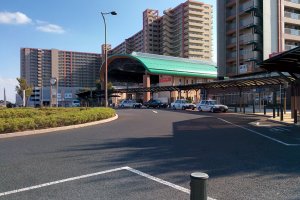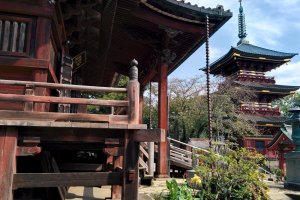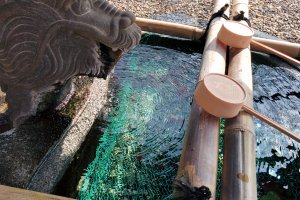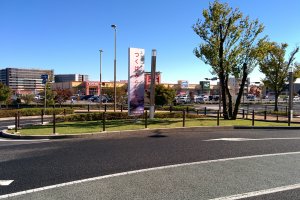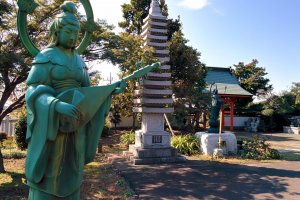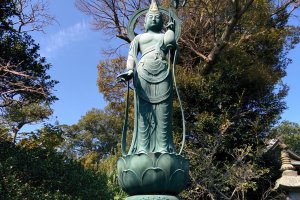Formed in 2006 when the towns of Ina and Yawara merged, Tsukuba-mirai is located in the south-west corner of Ibaraki prefecture and served by the Tsukuba Express (TX) line at Miraidaira. With a small population around 50,000 people, it is a rapidly developing part of Ibaraki and will continue to grow into the future. Whilst not on the main tourist path for most visitors to Ibaraki, there is a lot to see and do if you look for it and here you can find an overview of what to expect:
Itabashi Fudouson Shrine

The largest shrine in Tsukuba-mdirai, Fudouson Shrine is located in the Itabashi area, not too far from Warp Station Edo.
As well as the main shrine, there is a pagoda and several other buildings in the complex, including many statues, a chōzuya and a large display of ema wooden plaques.
Views of Mount Tsukuba

Across most of Tsukuba-mirai, if it is a good day you'll come across spectacular views of Mount Tsukuba in the distance, which dominates the skyline across Ibaraki and is one of the Hyakumeizan, or 100 mountains of Japan. On a clear day, if the cherry blossom is out and you are nearby the rice fields, the views get even better.
Komyoin Temple

This small temple can be found west of Miraidaira Station. It is usually very quiet and a fairly small site, but offers a number of features to admire and several statues. It sits atop a hill overlooking a vast plain of rice fields, providing panoramic views over the area.
Tonkatsu Marugen

This small tonkatsu restaurant is west of Miraidaira Station and down the road from Komyoin Temple (above). Needless to say they serve great tonkatsu dishes, with a variety of options and set menus, using pork sourced locally from around Ibaraki prefecture.
Mirai-no-mori Park

Not too far north of Miradaira Station is this small park suitable for families and joggers alike. With a recreation area, running path around the perimeter, lots of exercise spots and a hilly terrain, it suits all types of visitors. The outdoor gym equipment allows active types to train or keep older residents active. There are also climbing frames available for children.
Miraidaira Station

This is the gateway to Tsukuba-mirai and provides quickest access to most of the places listed here. Miraidaira Station is the 16th stop on the Tsukuba Express (TX) line, providing direct trains to Tsukuba in the north, and Kita-Senju and Akihabara in Tokyo.
Mamiya Rinzo Museum
Mamiya Rinzo was a Japanese explorer of the late Edo period, commemorated at this Mamiya Rinzo Museum (間宮林蔵記念館) in south Tsukuba-mirai, near Moriya Station (TX).
Maruyama Nori Store
Located near Midorino Station on the TX line, this Maruyama Nori (丸山海苔店) shop is where the Tsukuba factory is located. Specialising in seaweed and green tea, it's the seaweed most well-known here, supplied to thousands of sushi bars across Japan.
———
Warp Station Edo [Restricted access]

Please note that, since March 2020, the facility is no longer open to the public. The venue still operates as a filming set for commercial shooting.
In central Tsukuba-mirai City you will find Warp Station Edo, a detailed replica of a traditional Edo-period town. Run by the state broadcaster NHK, Warp Station Edo is used for filming 17th century period dramas and films but is also open to the public.
It makes a great trip for visitors looking to explore this part of Ibaraki, not to mention take a step back in time.
Menya Mirai 69 [Closed]

If you need to find a good lunch spot, Mirai 69 offers great ramen and is located a few minutes north of Miraidaira Station.
There are a number of types of ramen on the menu, most notably Assari Shio, as well as regular options e.g. miso ramen. Also available are the full complement of sides, such as gyouza/chahan, and a number of set deals on weekdays.
Tatsunami Sumo Stable [moved]

This stable relocated to Tokyo in 2021.
The Tatsunami sumo stable, in Tsukuba-mirai, Ibaraki, is one of the most prestigious stables in sumo history. Founded in 1876 by Onigazaki, the current incarnation dates back to 1915. Asahiyutaka Katsuteru is the current Tatsunami elder/owner and has lead the stable since 1999.
The stable is not accessible to regular visitors or tourists, although can be accessed by those who sign up to the Tatsunami-beya Supporter's Association (annual fee applies). Membership grants access to a multitude of gatherings and events in the area.


